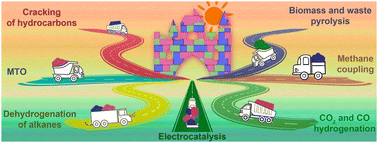Light olefin synthesis from a diversity of renewable and fossil feedstocks: state-of the-art and outlook†
Abstract
Light olefins are important feedstocks and platform molecules for the chemical industry. Their synthesis has been a research priority in both academia and industry. There are many different approaches to the synthesis of these compounds, which differ by the choice of raw materials, catalysts and reaction conditions. The goals of this review are to highlight the most recent trends in light olefin synthesis and to perform a comparative analysis of different synthetic routes using several quantitative characteristics: selectivity, productivity, severity of operating conditions, stability, technological maturity and sustainability. Traditionally, on an industrial scale, the cracking of oil fractions has been used to produce light olefins. Methanol-to-olefins, alkane direct or oxidative dehydrogenation technologies have great potential in the short term and have already reached scientific and technological maturities. Major progress should be made in the field of methanol-mediated CO and CO2 direct hydrogenation to light olefins. The electrocatalytic reduction of CO2 to light olefins is a very attractive process in the long run due to the low reaction temperature and possible use of sustainable electricity. The application of modern concepts such as electricity-driven process intensification, looping, CO2 management and nanoscale catalyst design should lead in the near future to more environmentally friendly, energy efficient and selective large-scale technologies for light olefin synthesis.



 Please wait while we load your content...
Please wait while we load your content...